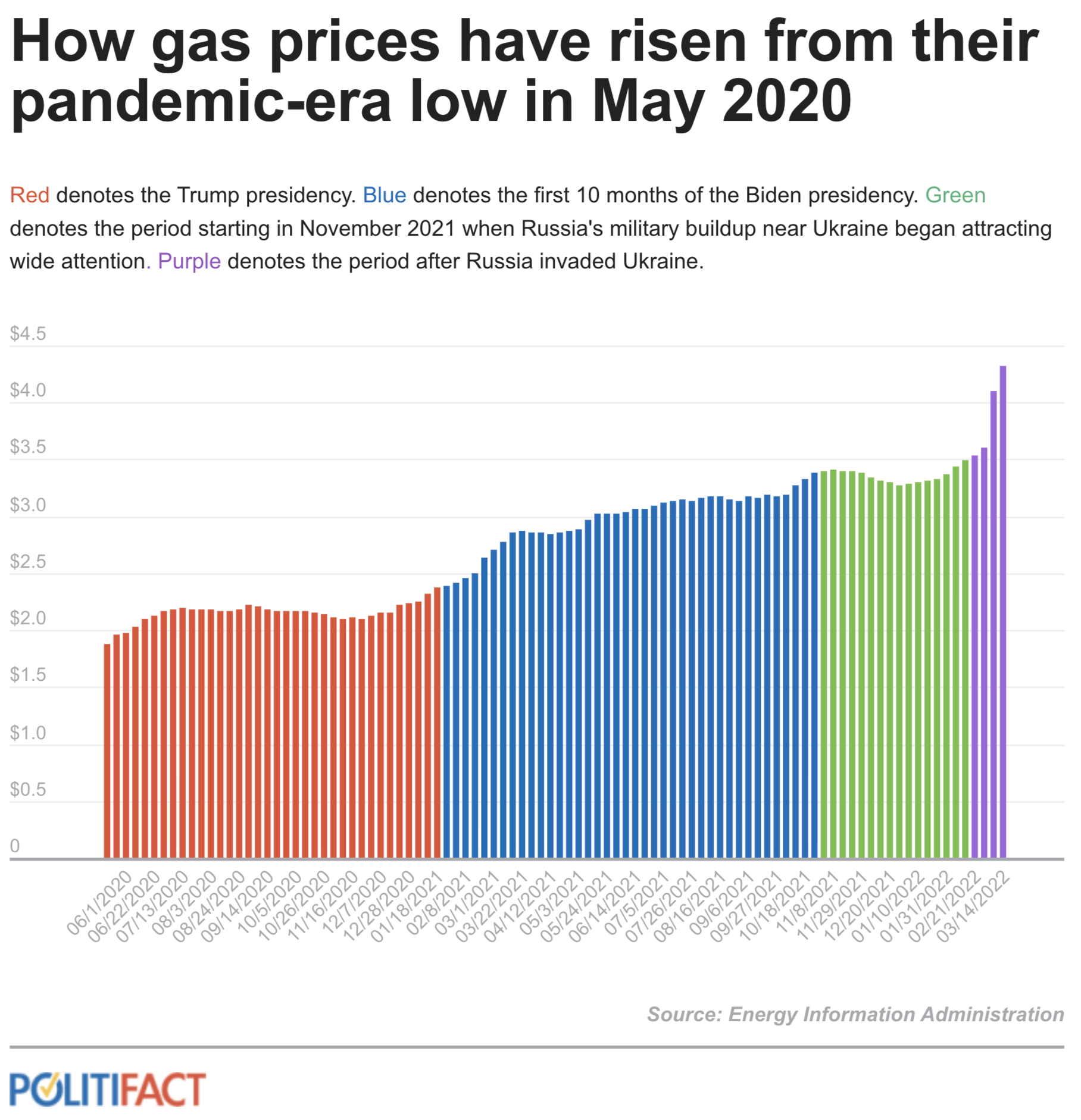President Joe Biden recently cast blame for a spike in gas prices on Russian President Vladimir Putin.
“We’ve seen the price of gas go up over $1 just since he put his troops on the border of Ukraine,” Biden said in an address to the National League of Cities on March 14. “It went up $1.05. A big part of that reason is Putin began amassing troops along the border and then crossed (it). And guess what? The world took notice. The market anticipated; prices went up. And then Putin invaded.”
Biden continued, “Make no mistake: The current spike in gas prices is largely the fault of Vladimir Putin. It has nothing to do with the American Rescue Plan,” referring to the big coronavirus and economic relief package Biden pushed through Congress and signed early in his presidency.
Gasoline prices have risen most aggressively since Putin began preparing his invasion of Ukraine.
“Current,” however, is doing a lot of work in Biden’s remarks, which ignore a long run-up of gas-price increases prior to the escalation of military conflict in Ukraine. And while assessments differ over how much the American Rescue Plan promoted inflation generally, the legislation is widely credited with aiding the nation’s economic recovery, which in turn increased demand for gasoline and pushed prices higher.
“Gasoline and crude oil prices overall have increased significantly over the past year due to a variety of factors, mainly driven by increased demand due to recovery from the COVID pandemic and associated problems with the supply chain and employment,” said Hugh Daigle, an associate professor at the University of Texas-Austin’s Center for Subsurface Energy and the Environment.
The United States imports some crude oil from Russia, but Russian oil has a relatively small footprint in the U.S. market. Recent data shows Russian imports accounting for about 7% of total U.S. imports; in turn, imports are roughly equal to U.S. crude oil production, making the importance of Russian oil even more modest.
That said, the price of oil is determined by international factors, and because other countries are more heavily dependent on Russian oil than the U.S. is, any cutbacks in the use of Russian oil elsewhere can reduce global supplies, pushing prices higher for U.S. consumers.
To put Putin’s impact on U.S. gasoline prices in context, we looked at weekly per-gallon gasoline prices from the U.S. Energy Information Administration, dating back to the low point for gas prices in May 2020. That was just a few months into the coronavirus pandemic, when commuting and travel had slowed dramatically, producing low demand and low prices for gasoline.
In mid-May 2020, gas prices sat at around $1.88 a gallon. By late January 2021, when President Donald Trump left office and Biden was sworn in, a gallon of gas had risen to about $2.39 a gallon, an increase of about 50 cents.
From Biden’s inauguration until early November, the price of gas continued to rise: It reached $3.39 in early November, or an increase of about another dollar.
We chose November 2021 as a turning point because that’s when a continuing Russian troop buildup on Ukraine’s borders began to attract wider notice. On Nov. 3, Ukrainian officials said the number of Russian troops on its borders had reached 90,000, and on Nov. 10, the Biden administration offered public warnings about the military buildup.
By early December, the buildup and potential invasion became widely known to news consumers in the U.S., documented in the New York Times and other publications.
Between early November and the start of the Russian invasion in late February, U.S. gas prices rose modestly, climbing 10 cents to $3.49.
The big spike came when the invasion began, with the price of gas rising by 83 cents to $4.32.

(PolitiFact)
So Putin’s invasion clearly caused the single biggest gas price spike during this period. And gas prices did rise during the four-month-long build-up to the invasion.
What Biden’s comment leaves out is that the gas price rise following Putin’s military buildup accounted for a fraction of the overall rise in gasoline prices.
Looking at the entire period starting with March 2020, the low point for gas prices, only about 38% of the price increase to today came during the period when Putin was threatening or conducting war in Ukraine. The remaining 62% of the rise had already occurred before the buildup became a major story in November.
And even if you only look at the rise during Biden’s tenure in office, less than half of the rise in gas prices occurred before the troop buildup became big news in November 2021.
So if Putin’s war plans aren’t “largely” the cause of the increase in gas prices, what other factors played a role? The big one is the economic recovery from the pandemic.
When the U.S. economy began sputtering back to life during the second half of 2020, it increased demand for oil, which in turn pushed up gas prices.
“I think it’s fair to say that much of the run-up happened before Russia’s buildup became a focus, and was driven by the post-COVID recovery in global demand,” said Mark Finley, a fellow at Rice University’s Center for Energy Studies. Finley added that a longstanding refusal by the OPEC oil cartel and its allies to increase production has added to the upward pressure in prices.
Dean Baker, co-founder of the liberal Center for Economic and Policy Research, agreed. “Biden was definitely overstating the case” in blaming Putin as the primary driver of high gas prices, Bake said. “Clearly, the recovery was a factor in gas prices.”
It’s important to note that some of the early rise in gas prices after March 2020 was simply a “return to a more ‘normal’ supply-demand balance” following the extraordinary economic shutdowns of the early pandemic, said Clark Williams-Derry, an energy finance analyst at the Institute for Energy Economics and Financial Analysis.
He added that a significant part of why supply has trailed demand for the past two years is low investment in production during the pandemic, due to uncertainty about how to plan for a recovery.
“Oil prices and oil markets are influenced by a complicated, multi-directional, global network of causes and effects,” he said. But he added that “any analysis of oil price shifts since 2019 that doesn’t put COVID front and center is flat out wrong.”
The White House’s response
The White House acknowledged to PolitiFact that Biden did not mean to suggest that every cent of increase since May 2020, or since January 2021, was attributable to Putin, and they said that a number of factors have fed into the overall increase in gas prices.
Instead, the White House focused on Biden’s use of the term “current spike,” saying that the most recent rise does stem largely from Putin’s actions.
In the meantime, it’s important for everyone “to avoid a U.S. bias,” Williams-Derry said. “Oil prices are set globally, so there’s a tendency to blame U.S. politicians for things that they have literally no control over.”
Our ruling
Biden said, “Make no mistake: The current spike in gas prices is largely the fault of Vladimir Putin.”
By current, Biden means very current. The most recent spike in gas prices has stemmed largely from Putin’s invasion of Ukraine.
But gas prices were rising before the Russian troop buildup around Ukraine became front-page news. About two-thirds of the price rise since gas prices’ low point in May 2020 came before the Ukraine buildup became a major international story, an increase that experts say stemmed primarily from the economic recovery following the pandemic.
The statement is accurate but needs clarification or additional information, so we rate it Mostly True.
This fact check was originally published by PolitiFact, which is part of the Poynter Institute. It is republished here with permission. See the sources for this fact check here and more of their fact checks here.







